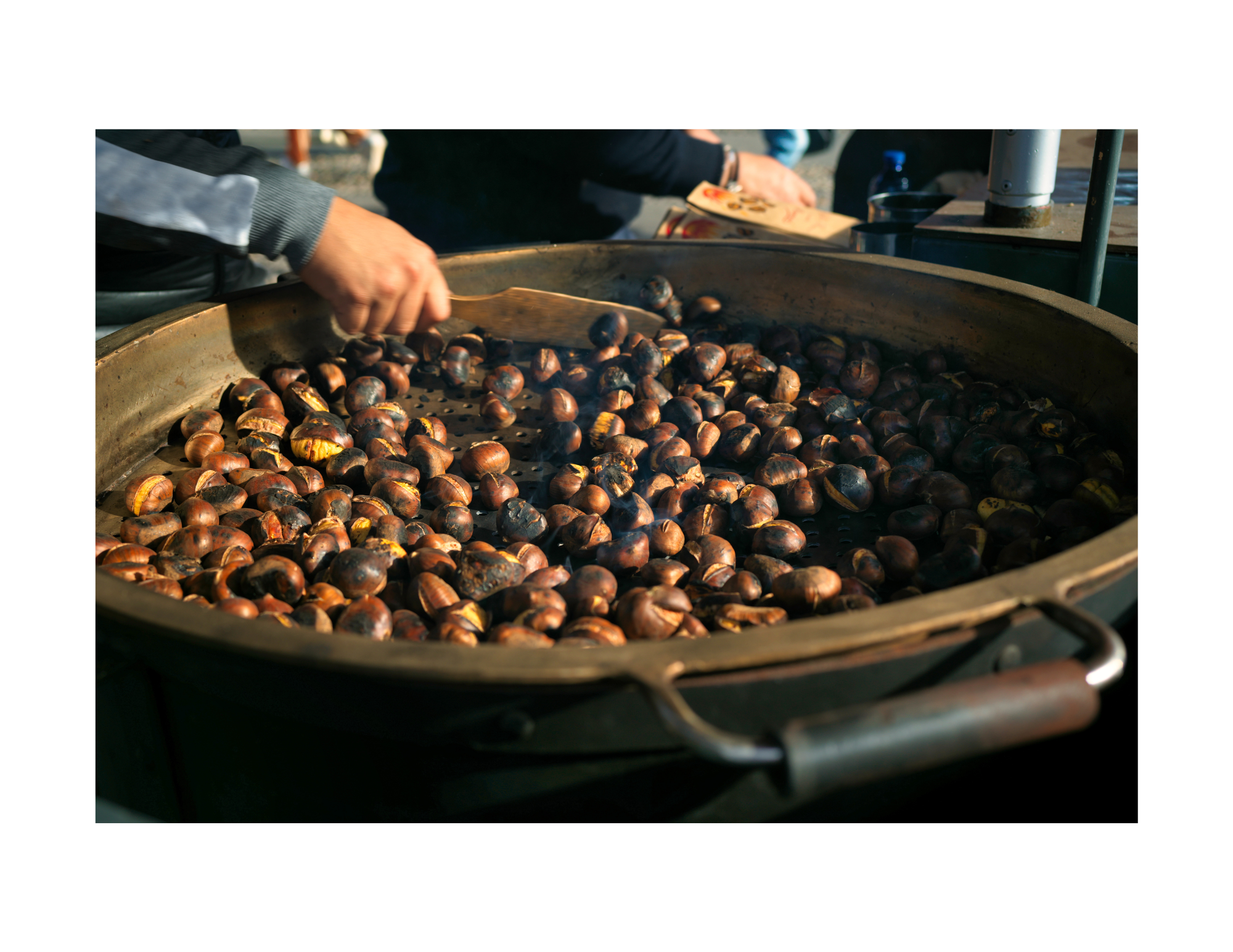St. Martin’s Summer Meets Indian Summer: A November Guide for New American Residents in the Algarve
St. Martin’s Day, celebrated on November 11th, marks a pivotal moment in Portuguese agricultural life. Across the Algarve, this tradition comes alive with food and wine events hosted by local wineries, showcasing the season’s bounty through modern culinary artistry and time-honored practices. Central to these celebrations is the Magusto, where roasted chestnuts, fresh wines, and a festive atmosphere bring people together in a joyous embrace of tradition

Posted on Sun 17 Nov 2024 · by Gloria Dall'Orto
Autumn’s arrival in the Algarve brings with it a unique climate phenomenon: a brief period of warm, sunny days between the early chills of fall and the onset of winter. Known as “St. Martin’s Summer” in Portugal and other Catholic countries, this tradition resembles the “Indian Summer” celebrated in Anglo-Saxon countries. The legend of St. Martin explains that, after sharing half of his cloak with a cold, shivering beggar, the skies cleared and warmed in honor of his generosity. In England and the U.S., this phenomenon of sudden autumn warmth is called “Indian Summer.”
For the growing number of Americans settling in the Algarve, here’s a guide to understanding the similarities and unique local traditions tied to St. Martin’s Summer in Portugal.
St. Martin’s Summer: A Southern European Tradition
In Catholic countries like Portugal, Spain, and Italy, St. Martin’s Summer is celebrated on November 11th. It often coincides with a few mild autumn days, seen as a “gift” from fall before the winter cold sets in. St. Martin of Tours, a Roman soldier, is celebrated in this period for his kindness; while in Amiens, France, he encountered a cold beggar and cut his cloak in two, offering half to the man. According to the legend, the skies cleared as a tribute to St. Martin’s compassion, bringing a brief spell of warm, summer-like weather.
In the Anglo-Saxon tradition, the concept of “Indian Summer” also represents a warm, calm period following the season’s first frost, typically between late September and November. The term’s origin is uncertain, with some theories suggesting it relates to Native American hunting practices, as the warm days gave extra time to gather food supplies for the winter. It was first documented in the U.S. in a letter from a French writer, John de Crèvecoeur, in 1778, describing a “calm and warm period” in the territory of the Mohawks as “Indian Summer.”
The notion of a brief warm period in autumn isn’t unique to the U.S.; the U.K. also references “Saint Martin’s Summer” in connection with the same tale of generosity and good weather.
Celebrating St. Martin’s Day in Portugal
In Portugal, St. Martin’s Day, or Dia de São Martinho, is celebrated on November 11th. This day marks the start of the wine-tasting season, especially for the new wine, known as vinho novo or vinho de São Martinho, accompanied by a tradition of roasting chestnuts, or castanhas assadas. St. Martin’s Day is symbolic as it marks the transition in agriculture from harvest season to winter rest. With the first stage of fermentation completed, the new wine is ready for tasting, symbolizing the season’s end with community gatherings and traditional feasts across the country.
It’s a magical time when the must is still fermenting, and the anticipation for the fresh, fruity “vinho novo” builds, leading to popular festivals and fairs in the Algarve and beyond. The vibrant foliage and clear autumn days make it a beautiful period to enjoy Portugal’s rich traditions.
Key Elements of St. Martin’s Day in Portugal
- The 'Magusto'
The Magusto is a beloved tradition where families and friends gather around fires to roast chestnuts together. These gatherings take place in both cities and small towns, often around large bonfires, and bring together friends and family for a warm, festive celebration. In addition to roasted chestnuts, people enjoy água-pé, a traditional drink similar to a light wine made by adding water to the grape remnants left after pressing. In some regions, jeropiga, a sweet alcoholic drink made by mixing must with brandy, is also popular.

- Roasted Chestnuts (Castanhas Assadas)
On Dia de São Martinho, roasted chestnuts take center stage, with their distinctive aroma filling streets and squares. Traditionally cooked over special grills or perforated pots, roasted chestnuts are often sold by street vendors and are seen as a symbol of abundance, historically serving as a staple food for rural communities. Collecting and roasting chestnuts is a ritual that marks the true arrival of fall.
- Vinho Novo
On St. Martin’s Day, wineries and adegas (small wine cellars) open their doors to share the first taste of vinho novo, a young, fresh, and light wine. For those seeking to deepen their appreciation of fine wines, the Algarve offers a wealth of exceptional experiences. From curated tastings to intimate vineyard tours, there is a world of flavors and stories waiting to be discovered. Click here to explore further.

As tradition says, “No dia de São Martinho, vai à adega e prova o vinho” (“On St. Martin’s Day, go to the cellar and taste the wine”). This year in the Algarve, many food and wine events were organized by local wine estates, each with its own menu—rooted in either tradition or innovation, but always with a spirit of conviviality.
Among the most memorable events this year were:
• November 8th - ARVAD, Silves: This stunning wine estate, perched on a terrace overlooking the picturesque Arade River, hosted a special dinner featuring two talented chefs: Daniel Estriga with his restaurant 'CONCEITO' based in Cascais and João Sá with his 'SALA' in Lisbon. The four-hands dinner was a masterpiece, combining refinement with the distinct character of the wines produced at ARVAD, including their famous amphora-aged wine. Guests enjoyed a fine dining experience that harmonized beautifully with the estate’s unique offerings.
• November 10th - QUINTA da Tôr, Benafim: Located in the heart of the Algarve’s Barrocal region, Quinta da Tôr opened its doors to guests for a more intimate celebration of St. Martin’s Day. Mario, the passionate owner and winemaker, greeted loyal customers and new visitors alike, offering a chance to taste the estate’s excellent wines alongside traditional petiscos—such as roasted chestnuts, local cheeses, and enchidos (Portuguese sausages). The warm hospitality of Quinta da Tôr made it a welcoming stop for those eager to explore the Algarve’s rich terroir.
• November 11th - Quinta dos Capinhas, Lagoa: On the day of São Martinho, Quinta dos Capinhas invited Rogério from Lagoa’s popular Gaspacho & Migas restaurant to create a menu that reflected the season’s freshest ingredients. Guests enjoyed a delicious meal that celebrated the flavors of the Algarve, paired expertly with wines from the estate.
• November 16th - PAXÁ WINES, Silves: PAXÁ, one of the Algarve’s most beloved wineries, hosted a traditional celebration with a focus on quality and continuity. Tiago, the young owner, invited guests to enjoy a Porco no Espeto (roast pig) feast, an iconic Portuguese dish, featured by 'Feito no Zambujal': pork on the spit and PAXÀ renowned Negramole, what a perfect match!
Cheers Everyone!
